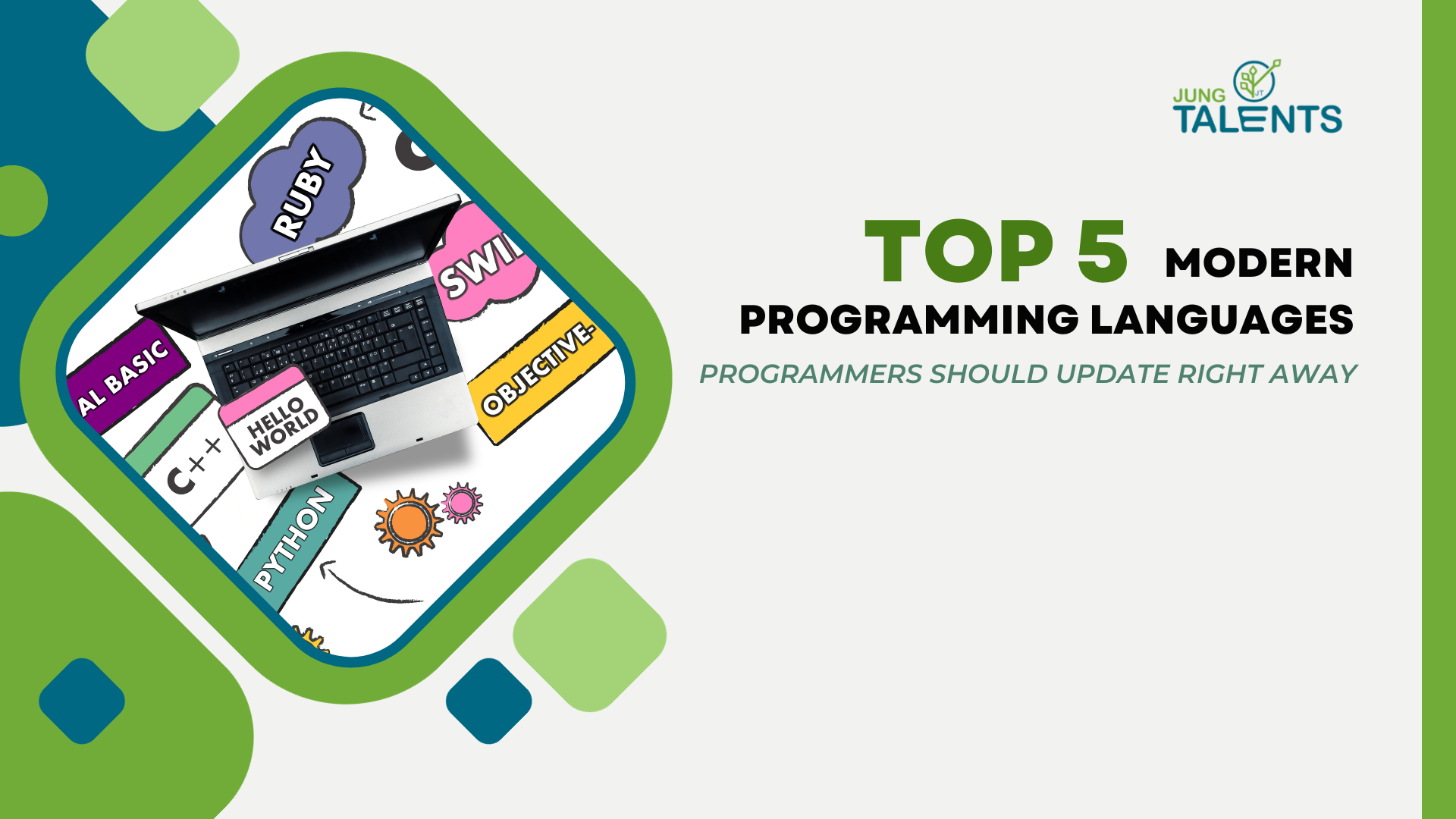5 MODERN PROGRAMMING LANGUAGES PROGRAMMERS SHOULD UPDATE RIGHT AWAY

Emerging programming languages like Rust, Go, Kotlin, Swift, and TypeScript can significantly boost your software development career!
Learning a new programming language is a substantial investment in terms of time, energy, and intellect, but it comes with numerous benefits for developers. This article does not undermine the importance of traditional programming languages but simply provides you with a list of modern programming languages that can enhance your work productivity and advance your career. The list below covers various domains: system programming, application development, web development, scientific computing, and more.
1. Which languages are considered "modern programming languages"?
The term "modern programming language" is somewhat vague. Many people consider Python and JavaScript as modern programming languages, while viewing Java as an older one. In reality, all three of these languages were introduced around 1995. Most mainstream programming languages were developed in the previous century, mainly in the 1970s (e.g., C), 1980s (e.g., C++), and 1990s (e.g., Java, Python, JavaScript). Consequently, these languages were not designed to take full advantage of modern software development ecosystems, such as multi-core CPUs, GPUs, fast networks, mobile devices, containers, and the cloud. Despite having added features, they still exhibit backward compatibility and cannot shed their outdated features. This list will consider programming languages that emerged after 2007.
2. Why should you learn modern programming languages?
Firstly, modern programming languages are developed to maximize the benefits of modern computer hardware (as listed above). Additionally, most modern programming languages have significantly higher Ergonomics, with features like:
- Shorter code (less verbose)
- Built-in support for Concurrency
- Null Safety
- Type Inference
- Much simpler feature sets
- Lower cognitive load
Combining the best features of all programming paradigms Secondly, the programming languages in this list are either already mainstream or poised to make breakthroughs in the software industry in the coming decade. Let's begin by examining each "promising young name"!
3. Modern Programming Languages You Should Update Right Away
3.1. Rust
The landscape of system programming languages has long been dominated by meta-programming languages like C and C++. While they provide full control over programs and hardware, they lack memory safety. Other popular programming languages like Java, Python, and Haskell offer safety but come with a significant runtime or virtual machine overhead, making them unsuitable for system programming. There have been many efforts to combine the power of C/C++ with the safety of Haskell and Java, and Rust is the first production-ready programming language to achieve that. Rust was first released in 2015 and quickly gained popularity within the developer community.
Key Features:
- Provides Memory Safety and Concurrency Safety through Ownership and Borrowing.
- Compile-time guarantees for memory and concurrency safety, which is Rust's most compelling feature.
- Offers the expressiveness of ML and Haskell. With immutable data structures and functional programming features, Rust provides both Functional Concurrency and Data Concurrency.
- Rust is exceptionally fast.
- Since Rust has no runtime, it provides full control over modern hardware (TPU, GPU, multi-core CPUs).
- Rust supports LLVM, enabling excellent interaction with Web Assembly and rapid web code development.
Popularity: Since its debut in 2015, Rust has gained acceptance within the software development community and has been voted as the most loved programming language for four consecutive years (2016, 2017, 2018, 2019) in StackOverflow surveys. With these features, it's no surprise that tech giants like Microsoft, Amazon, and Google have finally declared long-term investments in Rust as a system programming language. According to Google Trends, Rust has shown steady growth over the past five years.
Primary Use Cases:
- System programming
- Serverless computing
- Business applications
Competing Languages: C, C++, Go, Swift
3.2. Go
In 2012, Google released the first official version of the Go programming language. Go is also a system programming language, but unlike Rust, it has a runtime and garbage collector (a few megabytes). However, unlike Java or Python, this runtime is packaged with the generated code. Ultimately, Go produces standalone binary code that can run on a machine without depending on any external runtime or dependencies.
Key Features:
- The simplest system programming language.
- Excellent support for Concurrency.
- Has a Garbage Collector, relieving software developers from memory management concerns as in C/C++.
- Google has heavily invested in Go, resulting in a rich set of supporting tools.
- Excelled in maintenance and widely used in enterprise applications.
Popularity: In 2009 (shortly after its release) and in 2018, Go entered the TIOBE index's Programming Language Hall of Fame. The success of Go paved the way for a new generation of programming languages like Rust. Go has now established itself as a mainstream programming language. Recently, the Go development team announced that they are working on Go 2, solidifying Go's position further.
Primary Use Cases:
- System programming
- Serverless computing
- Business applications
- Cloud-Native development
Competing Languages: C, C++, Rust, Python, Java
3.3. Swift
Swift was developed as a multi-purpose programming language. The first stable version of Swift was released in 2014. In addition to its compatibility with the LLVM Toolchain, Swift can interact with existing Objective-C codebases and has become the primary language for iOS app development.
Key Features:
- Simple and concise syntax.
- Provides null safety features and syntactic sugar.
- Being an interpreted language, Swift is as fast as C++.
- Supports the LLVM Toolchain, making it usable for server-side and web development (using WebAssembly).
- Offers Automatic Reference Counting (ARC) support to help manage memory correctly.
Popularity: Developers appreciate Swift like many other modern languages. According to StackOverflow surveys, Swift ranks 6th among the most loved programming languages. TIOBE's rankings placed Swift at the 10th position in 2019 (only five years since its inception). Google Trends also shows growth in its popularity, despite a slight decline during saturation.
Primary Use Cases:
- iOS app development
- System programming
- Client-side development (via WebAssembly)
Competing Languages: Objective-C, Rust, Go
3.4. Kotlin
JetBrains, the company behind IntelliJ IDE, developed Kotlin as a programming language that runs on the JVM, addressing some of Java's shortcomings and providing modern features. Google declared Kotlin as the top language for Android app development, further promoting its adoption within the IT community. Additionally, the Spring framework began supporting Kotlin in its ecosystem in 2017.
Key Features:
- Clean and concise code.
- High productivity.
- Like many other modern languages, Kotlin provides features such as Null Safety and Type Inference.
- Since Kotlin runs on the JVM, you can leverage the extensive existing Java library ecosystem.
- The top choice for developing Android applications.
- Backed by JetBrains and open-source, Kotlin has excellent tooling support.
- If the Kotlin Native (compiling Kotlin to native code) and kotlin.js (Kotlin to JavaScript) projects succeed, you can use Kotlin outside of the JVM.
- Allows for simple Domain-Specific Language (DSL) creation.
Popularity: Since its initial release in 2015, Kotlin's popularity has been skyrocketing. According to Stack Overflow, Kotlin was the fourth most loved programming language in 2019. Additionally, Kotlin maintains high rankings in other reliable programming language charts.
Primary Use Cases:
- Enterprise applications
- Android app development
Competing Languages: Java, Scala, Python, Go
3.5. TypeScript
JavaScript is an excellent programming language, but before 2015, it had several shortcomings. Google and many other major companies attempted to enhance JavaScript and produced results like CoffeeScript, Flow, ClojureScript, and more. However, TypeScript from Microsoft is considered the winner in this regard. A team of engineers at Microsoft, led by Anders Hejlsberg (creator of Delphi, Turbo Pascal, C#), created TypeScript as a statically-typed super-set of JavaScript.
Google was so impressed with TypeScript that they decided to collaborate with Microsoft to improve TypeScript and also use it as the primary programming language for the Angular2+ SPA framework. Furthermore, the Vue.js framework announced that they would use TypeScript for developing Vue.js 3.
Key Features:
- Like Go or Kotlin, TypeScript offers clean and robust code with static typing, making it one of the most elegant programming languages currently available.
- In terms of productivity, TypeScript can be on par with Kotlin on the JVM or Go/Python.
- TypeScript is the most effective JavaScript replacement, especially suited for large projects.
- The "big three" frameworks Angular, React, and Vue.js provide strong support for TypeScript. In Angular, TypeScript is the preferred programming language. In React and Vue.js, TypeScript is gaining popularity.
Popularity: Released in 2014, TypeScript quickly gained the attention of the community and became a favorite among software developers for its elegant design and convenient features. In Stackoverflow's Developer Survey, TypeScript ranked second alongside Python as the most loved programming language. Additionally, in GitHub Octoverse, TypeScript was ranked 5th in the list of fastest-growing web development programming languages. According to Google Trends, TypeScript has maintained stable growth over the past five years.
Primary Use Cases:
- Web UI development
- Server-side development
Competing Languages: JavaScript, Dart
Contact us:

